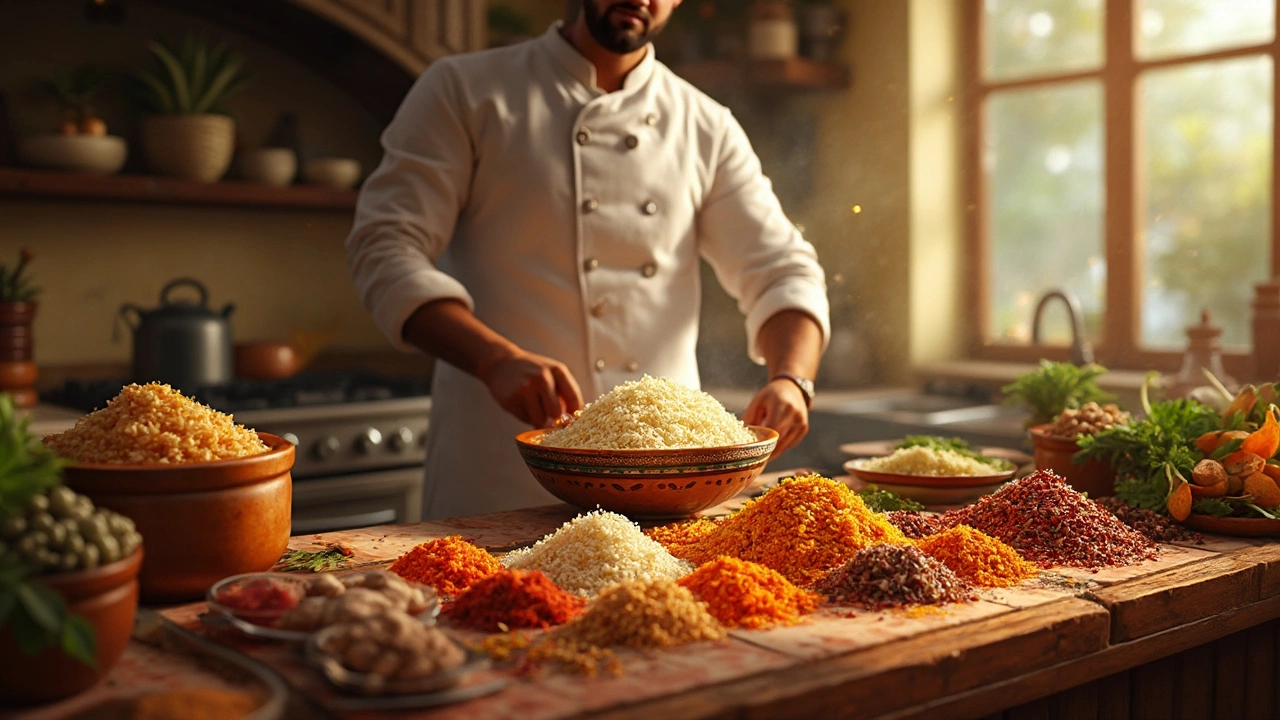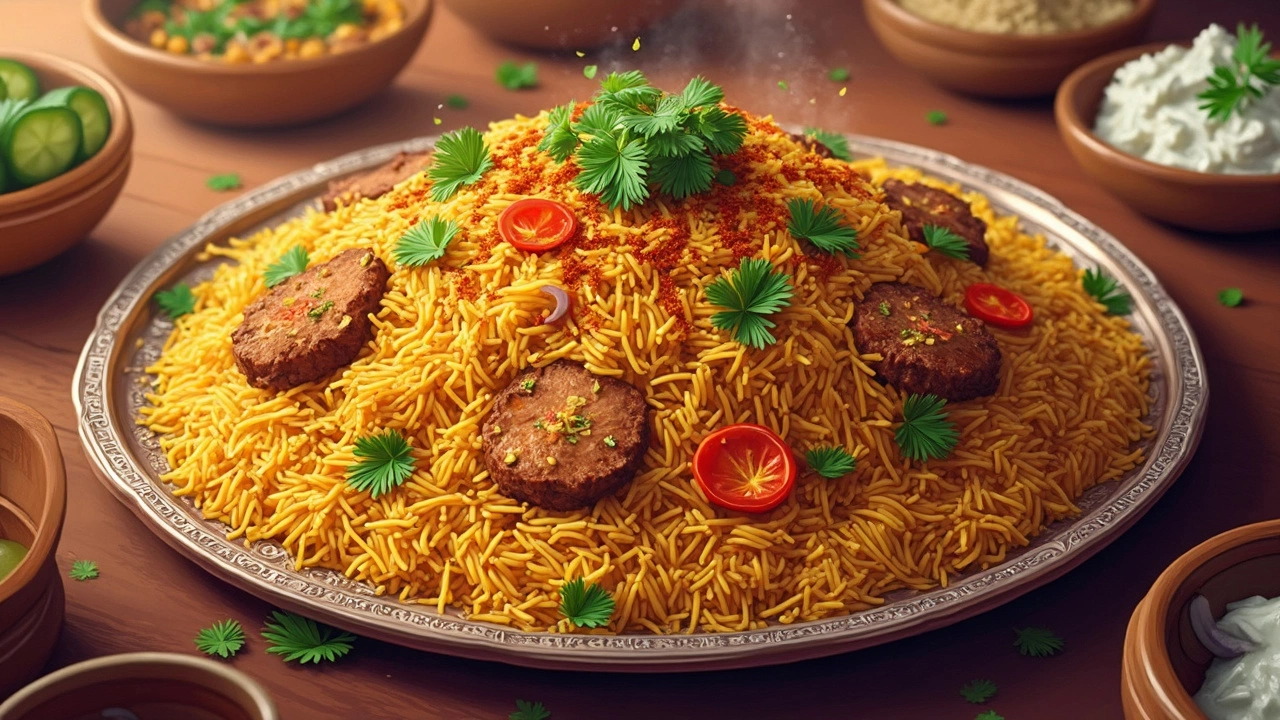Best Rice for Biryani: A Flavorful Guide

So, you're diving into the world of biryani, huh? It's such a flavorful dish, but nailing that perfect plate can be a bit like walking a tightrope. One wobbly step—and boom, you've got yourself a culinary disaster. But here’s the deal: choosing the right rice is the first big step toward biryani brilliance.
Now, many folks swear by basmati rice. It's long, slender, and when cooked right, doesn’t clump together. That's pretty ideal for biryani since no one wants a sticky mess. The aroma too—oh boy, it’s like a warm hug from your taste buds.
But hold on, there’s more to this story than just basmati. You see, each type of rice brings something different to the pot. If you're after a specific regional twist or texture, venturing beyond basmati might not be such a wild idea after all. Just give it a shot, and you could discover a whole new favorite.
- Understanding Biryani Basics
- Why Rice Choice Matters
- Basmati: The Gold Standard
- Short Grains and Their Place
- Cooking Techniques for Perfect Rice
- Tips for a Flawless Biryani
Understanding Biryani Basics
Alright, let’s get to the heart of it. Biryani isn’t just about tossing rice and meat together—it's a fragrant symphony of spices and textures. First, you need to get a grip on the parts that make up this dish. Think of it as layers, like a lasagna but with more flair.
Typically, biryani starts with marinated protein. Whether you go for chicken, beef, lamb, or even veggies, the marinade is where the magic begins, mixing yogurt, garlic, ginger, and a cocktail of spices like cumin, coriander, and turmeric.
Then there's the rice, which is where your choice of biryani rice becomes crucial. Traditionally, most chefs go for basmati rice—not only because it’s a superstar at soaking up flavors but also because its long grains don't turn into mush. You want that separation and fluffiness!
The masala or gravy part is next. This is your spice palette — onions, tomatoes, green chilies, and a dash more of those spices can make all the difference. Cook it slow and steady. The biryani is all about balance, after all.
The fun bit? The layering. You alternate between the cooked rice and the masala, topping it off with your protein. Toss in some saffron-infused milk for that signature yellow hint and fragrance, maybe a sprinkle of fried onions, and you’ve got yourself something magical.
And let's not forget the final steam. This slow-cooking little step or 'dum' in a sealed pot, ties everything together. It’s the crescendo of the biryani-making process. Knowing when and how just to let it steam can mean the difference between just food and a masterpiece.
Why Rice Choice Matters
If you've ever been knee-deep in the process of making biryani, you'll know that the type of rice you choose can make or break the entire dish. The thing about biryani is that it’s more than just a mix of spices and meat—it's a delicate balance where each grain of rice plays a lead role.
First off, texture is everything. A good biryani rice needs to be fluffy, and the grains should remain separate rather than clumped together. Imagine serving up a spoonful and watching each grain fall like a cascade—now that’s the visual appeal you’re going for! That's why basmati rice comes highly recommended; its long grain and non-sticky characteristics are just the ticket.
But texture isn’t the only thing to consider. The aroma of the rice also adds another layer of flavor. Basmati rice is celebrated for its fragrant nutty smell, almost like an unbottled essence of traditional cooking. Other rice types might not deliver the same punch, leaving your spices to do all the heavy lifting.
What about cooking time? Not every rice cooks the same way. Some require soaking, while others need precise water ratios. For folks new to the biryani game, playing around with different types of rice might seem risky, but it could open doorways to new textures and tastes that you might prefer.
| Rice Type | Cooking Time | Aroma |
|---|---|---|
| Basmati | 15-20 minutes | Nutty fragrance |
| Short Grain | 10-15 minutes | Less intense |
Last but certainly not least, the rice choice also impacts how the dish soaks up those savory spices. Given the layered nature of biryani, you want rice that absorbs just enough but still lets the sauce and meat flavors shine through.
So yeah, picking the right rice is crucial. It's like picking the right tool for a job; with the wrong one, you’re set for a struggle, but choose wisely, and you’re onto a feast that’ll have people reaching for seconds.
Basmati: The Gold Standard
When it comes to crafting the perfect biryani, you’ll often hear folks talking about basmati rice like it’s royalty of the rice world—and for good reason. This stuff really is special. Let’s break it down.
Basmati rice is long-grained and has a signature slender look. It's not just about appearances though; when you cook it, it stays nice and fluffy, with each grain hanging out solo rather than getting all mushy and clumped up. That’s crucial if you want each bite of your biryani to be a flavor-packed experience.
What really sets basmati apart is its aroma. When cooked, it releases a fragrant, nutty scent that wafts through your kitchen and makes your neighbors envious. This smell is thanks to a compound called 2-acetyl-1-pyrroline, which naturally occurs in basmati. It’s what gives basmati its unique position as the go-to rice for biryani.
On a practical note, basmati is a forgiving rice to work with, especially when you’re aiming for the whole fluffy, separate grain thing. Here’s a quick tip: rinsing and soaking it before cooking can make a huge difference. Rinse it a few times until the water runs clear—this gets rid of excess starch. Then soak it for about 30 minutes. It helps the grains expand even before they hit the heat.
Want more deets? Check out this table on the cooking properties of basmati that make it ideal for biryani:
| Property | Description |
|---|---|
| Grain Length | Long and slender |
| Texture | Fluffy and separate when cooked |
| Aroma | Fragrant, nutty scent |
| Water Absorption | Absorbs water, maintains shape |
So, if you're in the mood to make a killer biryani, trust in basmati. It's the foundation your dish deserves.

Short Grains and Their Place
When you think biryani, basmati rice often steals the spotlight. But hey, short grains like sona masoori also have a part to play, especially if you're diving headfirst into regional varieties of biryani. Sometimes the fluffier, slightly starchy nature of short grains brings out a comforting, down-to-earth vibe that’s hard to beat.
Take Bengal's 'Bhoger' biryani, for example. It’s all about those subtle flavors, and using short grain rice actually helps to soak them up. The rice sort of acts like a sponge, getting cozy with all those lovely spices, making every bite a burst of taste.
Now, cooking short grain rice for biryani isn’t too different from cooking the long-grain varieties, but there are a few tricks. Go easy on the water—too much, and you’ll end up with mush. Think of it like cooking pasta, keeping a close watch and not wandering off. Rinse the rice a few times before cooking too, washing away excess starch. This helps prevent it from turning into a sticky clump.
A dash of experimentation might lead you to a delightful discovery. So, don’t shy away from trying sona masoori or other short grains the next time you feel adventurous in the kitchen. You might just end up with a plate of biryani that surprises you!
Cooking Techniques for Perfect Rice
Cooking the best rice for biryani can seem tricky, but follow these techniques and you'll get those fluffy, separate grains every time. First things first, rinse that rice! Giving your basmati rice a good rinse removes excess starch. This stops it from getting all sticky once cooked.
Next up, let's talk soaking. Yeah, it’s an extra step, but it's worth it! Soak the rice for about 30 minutes. This makes the grains softer and helps them expand more when cooking. You’ll thank yourself when it's time to serve.
When it comes to cooking, precision is key. The water-to-rice ratio should be about 1.5:1. So, for every cup of rice, go with 1.5 cups of water. But wait, if you're using a different type of rice, play around with this ratio. Trust your instincts after a few tests—you'll get the hang of it!
Now, bring the water to a boil before adding the rice. Once it’s boiling, toss in the rice, give it a quick stir, and let it cook uncovered. Don't wander off; biryani rice cooks fast. It usually takes about 8-10 minutes.
Keep an eye on it. When most of the water is absorbed and you're seeing those little steam holes on the surface, it's time to cover it. Turn down the heat, and let it steam for another 5 minutes. This seals the deal and makes sure the rice is cooked through without being mushy.
And there you have it! Perfect biryani rice that's ready to soak up all those flavors. Give it some practice, and soon enough, you’ll be impressing your friends and family with your biryani skills!
Tips for a Flawless Biryani
Alright, ready to turn your biryani dreams into reality? Let’s make sure your biryani rice comes out just right, leaving everyone’s taste buds doing a happy dance.
First things first: rinse your rice. It sounds simple, but trust me, it's crucial. Rinse until the water runs clear to get rid of excess starch. This keeps your rice from sticking together, and nobody wants a sticky situation.
When it comes to soaking, give your basmati rice a leisurely soak in warm water for about 30 minutes. It kicks off the absorption process and makes sure your grains cook evenly and fluff up nicely.
For cooking, use the right amount of water. Generally, for one part rice, use about 1.5 parts water. But hey, if you’re kind of winging it and feeling adventurous, adjust as you see fit!
Go easy on stirring. Mix gently when you add flavors or blend ingredients. Keep those grains intact, and your biryani will look as good as it tastes.
Think about adding an aromatic bouquet garni to your pot. Toss in a small muslin bag with whole spices like cloves, cardamom, and cinnamon. It’ll infuse your rice with the most irresistible aromas without overpowering the dish.
Lastly, don’t rush the final steps. Once cooked, let the biryani rest for at least 10 minutes. It lets the flavors meld beautifully and gives you an even better taste experience.
Keep these tricks up your sleeve, and you’ll whip up a biryani that’s sure to impress. Ready to wow your guests or just treat yourself? Let’s get cooking!